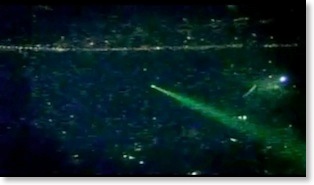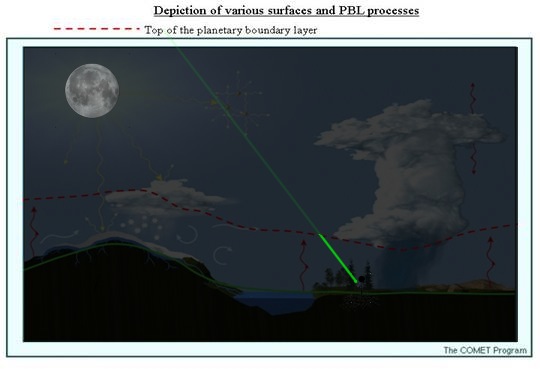Home
A comprehensive resource for safe and responsible laser use

Why laser beams outdoors seem to end
When you point a laser into the sky at night, the beam seems to end after a few hundred meters, as shown in this photo:

However, this is a dangerous illusion. A person can think their laser beam can’t reach an aircraft, since the beam looks “short”. They are of course mistaken.
Light from a laser does not stop in mid-air, but continues going. A pilot at the other end can clearly see the light from even a relatively low powered 5 mW green laser, at a distance well over 2 miles.

For a more powerful 50 mW green laser, the green “dot” is visible well over 7 miles -- even though to the user, the beam appears only a few hundred meters long. What is happening?
The Planetary Boundary Layer
For a laser beam to be visible, some of the light must reflect off particles such as dust, smoke or water vapor. In a zone near the earth’s surface, the atmosphere is full of these aerosols, helping to make outdoor laser beams visible.
But above the Planetary Boundary Layer (also known as the Atmospheric Boundary Layer), air is much cleaner. After the beam exits the PBL and enters cleaner air (fewer aerosols), much less light is reflected back. The beam seems to disappear.
The PBL thickness can vary from day-to-day and at different locations. Typically, it is a few hundred meters, up to a maximum of a few thousand meters. The illustration below shows the PBL:

Based on a NOAA diagram. We Photoshopped this into a nighttime view, to illustrate how a laser beam appears much brighter to the person holding it, as the beam passes through the aerosol-filled Planetary Boundary Layer only a few hundred meters above the earth’s surface.
For details about the Planetary Boundary Layer, see this article by Jeff Haby, and part 2 of an article about lasers in the atmosphere from Larry McNish of the Royal Astronomical Society of Canada.